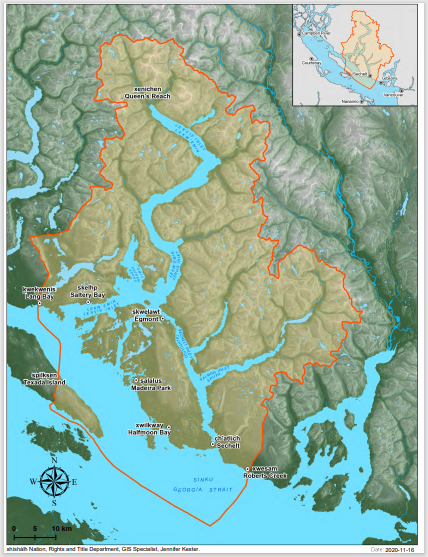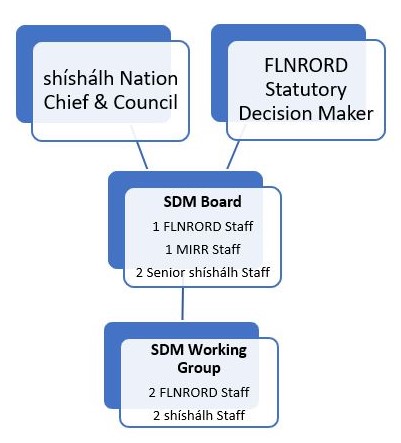shíshálh and B.C. shared decision-making
On October 4, 2018, the Foundation Agreement was signed by shíshálh Nation and B.C., committing the parties to shared decision-making (SDM) for land and resource authorizations throughout the swiya (lands, birthplace, world, "Territory" of the shíshálh Nation).
On this page
- About shared decision-making within the shíshálh swiya
- Shared decision-making process
- Land Act authorizations within the swiya
- Application requirements
About shared decision-making within the shíshálh swiya
shíshálh Nation is a governing entity responsible for the stewardship and protection of the shíshálh people’s relationship to the lands and resources of their swiya, and has title and rights protected and affirmed under section 35(1) of the Constitution Act, 1982.
shíshálh and B.C. are currently implementing the Foundation Agreement (PDF, 4.8MB), beginning with applications for all moorage types within the swiya. Eventually, all provincial authorization decisions related to land and resources within the shíshálh swiya will be incorporated into the shared decision making process.
Shared decision-making process
Applications related to land and resource authorizations are reviewed through the shíshálh Nation – B.C. Shared Decision-Making Process outlined in sections 4.38 to 4.60 of the Foundation Agreement (PDF, 4.8MB). As part of the review under the shared decision-making process, an application which falls within the shíshálh swiya is reviewed by a joint B.C.-shíshálh Working Group and Board. Distinct working groups exist for the various types of authorizations that are reviewed through shared decision making and are made up of staff with knowledge of the applications type (moorage, forestry, ground water, etc.).
The joint B.C.-shíshálh Working Group is comprised of staff from the shíshálh Nation and B.C. government. The Board is made up of representatives from shishalh Nation and multiple government ministries. When the working group has completed their review, a joint recommendation is made to the Board in consideration of a decision on the application. The Board's recommendation is then forwarded to shishalh Nation Chief and Council and the representative government's Statutory Decision Maker.
shíshálh Nation staff from B.C. at the Working Group and Board review the applications jointly and may make consensus or non-consensus recommendations on approval. If consensus on an authorization decision cannot be achieved, the issue is raised at a Solutions Forum comprised of representatives from B.C. and shíshálh Nation, as outlined in section 4.33 of the Foundation Agreement (PDF, 4.8MB)
Land Act authorizations within the swiya
Current proposed amendments to the shishalh swiya Dock Management Plan are ongoing.
As per the Foundation Agreement (PDF, 4.8MB), new and replacement applications for all Land Act decisions, beginning with private moorage (individual, strata, and group) and commercial moorage applications in fresh and saltwater environments within the shíshálh swiya will now go through the shared decision-making process.
The best management practices, developed collaboratively between shíshálh and B.C., incorporate Fisheries and Oceans Canada standards and will apply to all moorage applications within shíshálh swiya.
The best management practices apply if you want to conduct any of the following activities on swiya lands where the provincial Land Act applies (including foreshore but excluding private lands, municipal-owned fee-simple lands, shíshálh Nation Lands, and federal lands), within the area that is shown on the shíshálh swiya Area Map (PDF, 37.8MB):
- Construct a new, private (individual, group, or strata) or commercial moorage structure
- Make changes to or relocate a currently tenured moorage structure
- Obtain authorization for an existing moorage structure that is not currently authorized under a Land Act tenure
- Obtain a replacement tenure for an existing, tenured structure
- Repair or rebuild of a tenured dock, boathouse, or other moorage structure
The Best Management Practices do not apply to applications for:
- An administrative re-assignment of a tenure to a different tenure holder
- A consent to mortgage
- The modification of the provisions of a tenure
Application requirements
New moorage construction or authorization for an existing structure
If you are planning on constructing a new moorage structure or applying for authorization of an existing one, please make a new application through FrontCounter BC and provide the following:
- A Management Plan demonstrating compliance with the Best Management Practices and reviewed by a Qualified Professional
- A Preliminary Archaeological Field Reconnaissance (PAFR) Study by a Qualified Archaeologist
- An Environmental Assessment of the tenure area you are applying for by a Qualified Environmental Professional
Expiring tenure
If your tenure is expiring, you will be contacted by the Province and required to submit a replacement application that includes the following:
- A Management Plan demonstrating compliance with the Best Management Practices and/or plans to come into compliance and reviewed by a Qualified Professional
- A Preliminary Archaeological Field Reconnaissance (PAFR) Study if not conducted in the recent past
- An Environmental Assessment of the tenure area if you are proposing to change the footprint or to make major structural changes
Variances to the Best Management Practices may be considered in exceptional circumstances and must be supported by reports from qualified persons (P.Eng., R.P. Bio, and/or third-party dock builder).
Please see the Guidance Materials for Qualified Professionals conducting PAFRs or Environmental Assessments and Management Plan templates for additional information.
Modifications to existing moorage structures
Prior to undertaking any modifications to your moorage structure, please contact the Southcoast Regional Office. Modifications to existing docks or other private moorage structures within the swiya are expected to follow the best management practices and an updated management plan must be submitted.


